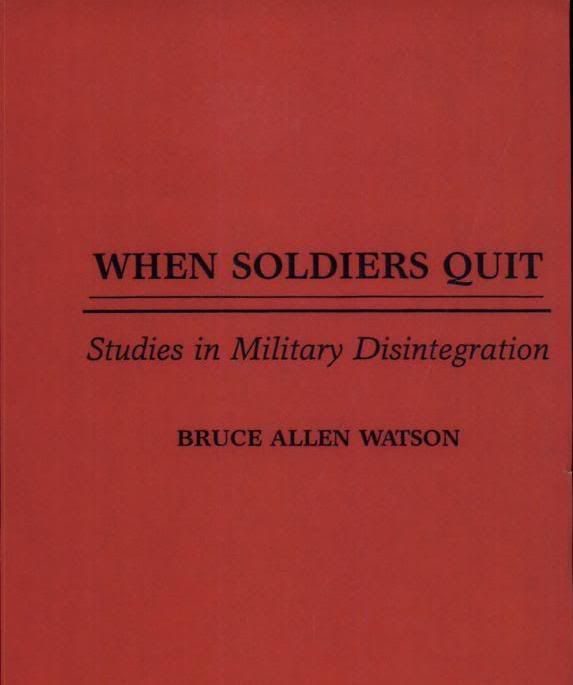Carl W.
Active Member
 Administrator
The Golden Lions
Administrator
The Golden Lions
Posts: 265
|
Post by Carl W. on Apr 25, 2009 8:17:16 GMT -5
This book dealts primarily about what happens when things go bad in battle and an army is faced with what is called "military desintegration".  After an introduction showing three examples of military disintegration, the author examines six historical occurrences in depth: - The India Mutiny of 1857 - The 1917 French Army mutinies - The depredations following British siege of San Sebastian,1813 - The surrender of elements of the U.S. 106th Infantry Division in 1944 - The Sand Creek Indian Massacre, 1864 - The My Lai massacre in 1968. The book has a whole chapter dedicated to the surrender of the 2 surrounded regiments of the 106th division and is a good read for a military historian or anyone who is interested in the division. Amazon lists it at 119$ (!!!) Carl |
|
|
|
Post by connie on Apr 30, 2009 19:32:37 GMT -5
Hi, Carl,
It would be interesting to know more about what you see in the focus of this book. This title could easily foster an old misconception.
There were a few reporters who were quoted again and again who spread untruths. Put something in print and it seems like truth. One in particular I have heard stated something to the effect that men in this division had given up without firing a shot. I believe that anyone who takes time to read the After Action Reports and other documentation will be convinced that just the opposite was true.
|
|
|
|
Post by Larry Heider on Apr 30, 2009 22:47:53 GMT -5
You bring up an interesting point Connie. As far as I know there were no reporters/writers/newsreel types present in the 106th sector on Dec. 16 other than US Army Corp personnel and it wasn't until around a week later that the situation changed. Is that a correct statement?
|
|
|
|
Post by connie on May 1, 2009 18:42:02 GMT -5
That's an interesting question. It will take someone who is more deeply steeped in the research than I am to give you a clear answer on what reporters may or may not have been in the area.
The only thing I have read that touches on this is an account of the whereabouts of a single reporter. This is the story with which John SD Eisenhower chooses to lead off his book Bitter Woods: The Battle of the Bulge.
Eisenhower tells of the journey of Philadelphia Inquirer reporter "Cy" Peterman from the 28th division command post in northern Luxembourg to the First Army Headquarters in Spa Belgium on the 15th of December 1944. According to Eisenhower, Peterman traveled along the road through 106th territory that Americans referred to as Skyline Drive as he journeyed from Luxembourg City through St. Vith, Belgium, to Spa. He was alarmed by the massive German troop movements he glimpsed along the route, and reported these to 1st Army commander Courtney Hodges.
So, according to this account, Peterman would not have been at the front at the time of the break-through. But, he would not have been far away.
Of other reporters I know nothing. I haven't seen anything written by Peterman, but I might make a stab at tracking his work down.
|
|
Carl W.
Active Member
 Administrator
The Golden Lions
Administrator
The Golden Lions
Posts: 265
|
Post by Carl W. on May 5, 2009 14:00:53 GMT -5
About the book:
It gives a good overview of the events of the battle but mainly consists of repetitions of previous books written on the 106th mainly quoting the Division history by Dupuy. Nothing really new here, I guess they just told the general story as fitting in the theme of the book.
Concerning reporters:
I'm sure there were some reporters in the area, however I don't think any were present in the 106th division area. Ernest Hemingway did stay in the area while he toured with the liberating 4th Division in September 1944. He stayed at a farm in Buchet, now known as Schloss Hemingstein and that would be know to the 106th as HQ Building for Colonel C.C. Cavender's 423rd Infantry Regt.
carl
|
|
Carl W.
Active Member
 Administrator
The Golden Lions
Administrator
The Golden Lions
Posts: 265
|
Post by Carl W. on May 5, 2009 14:03:03 GMT -5
For those of you who like to read parts of this book, it is available on Google-Books: See link When Soldiers Quit Carl |
|